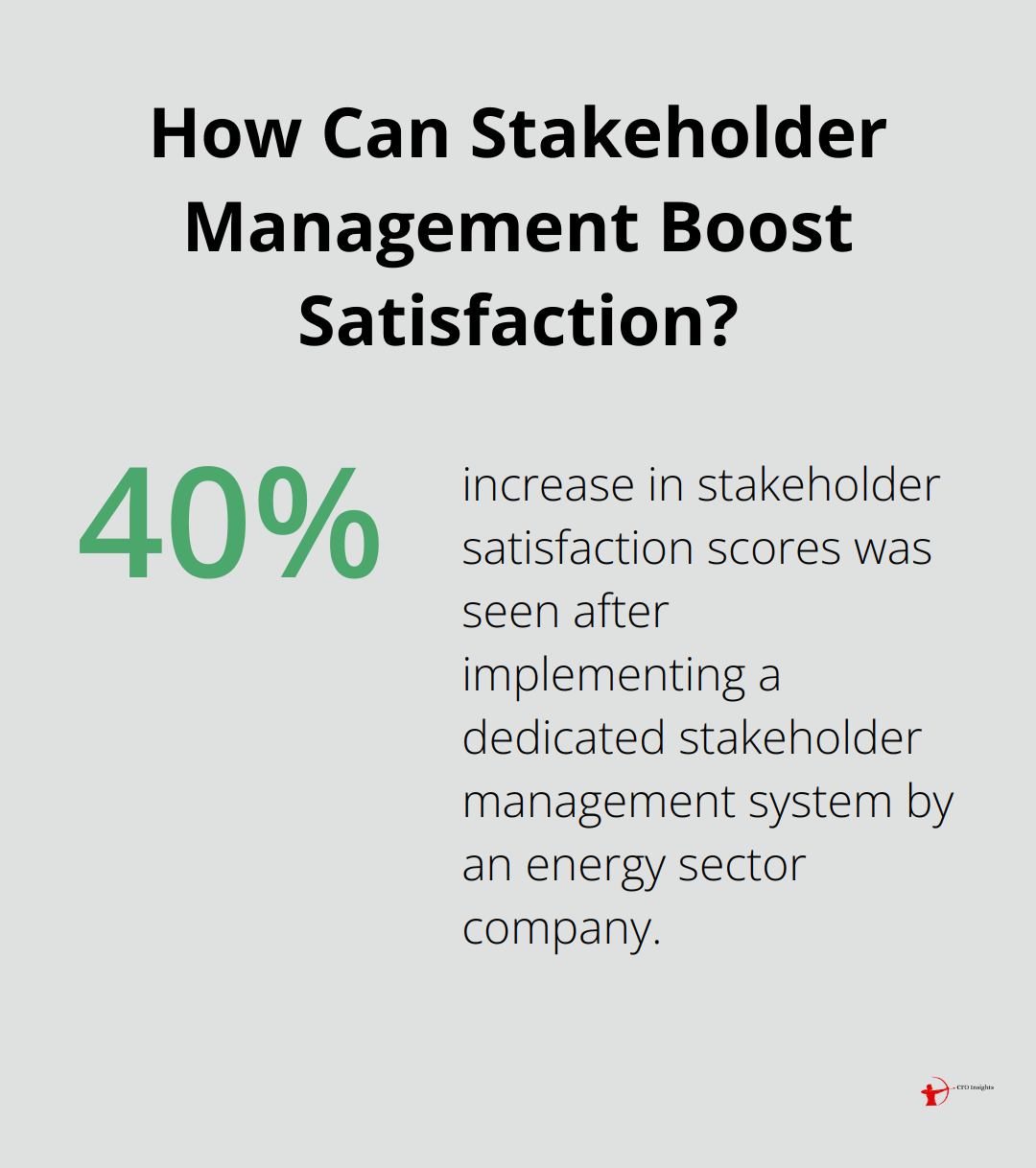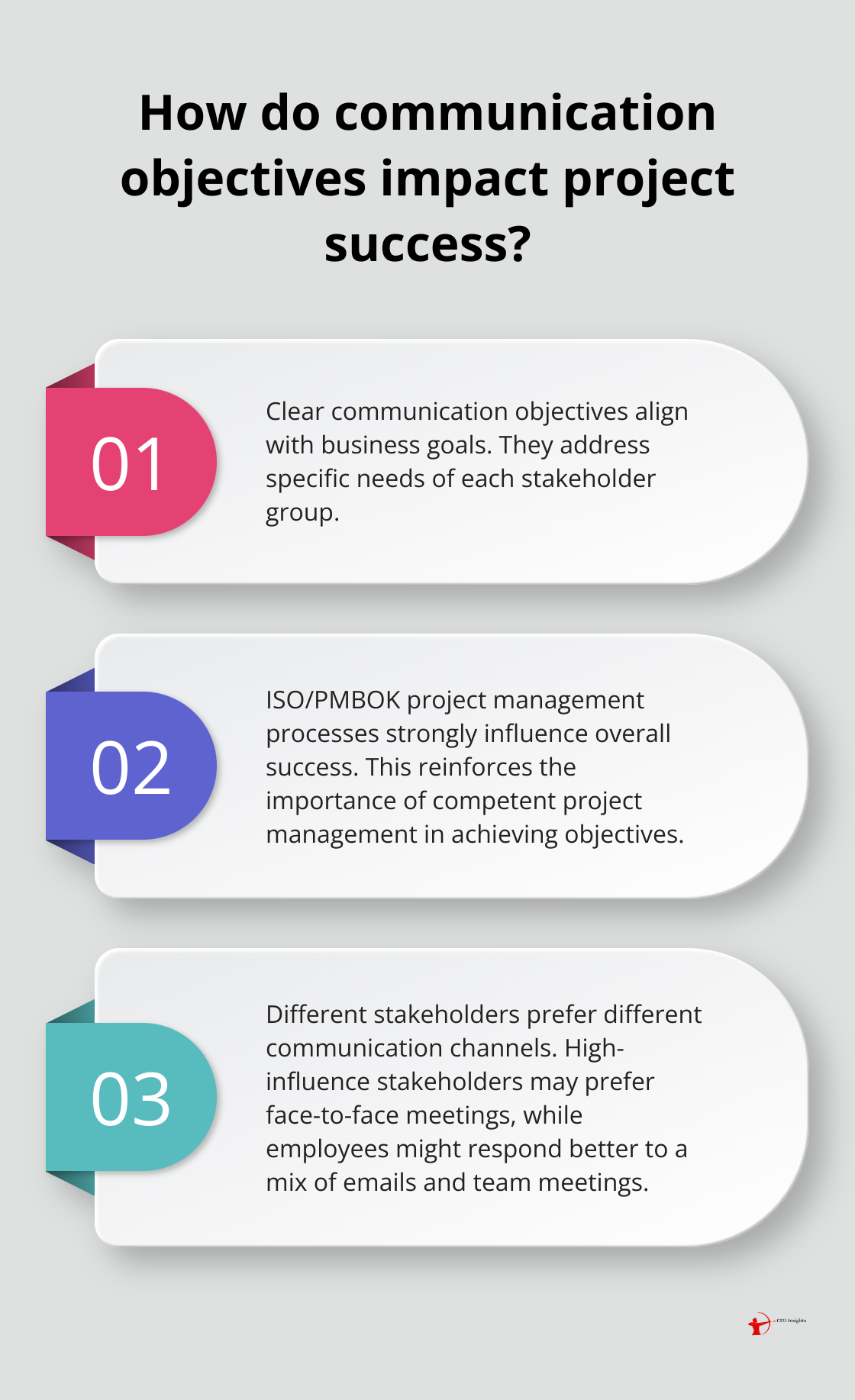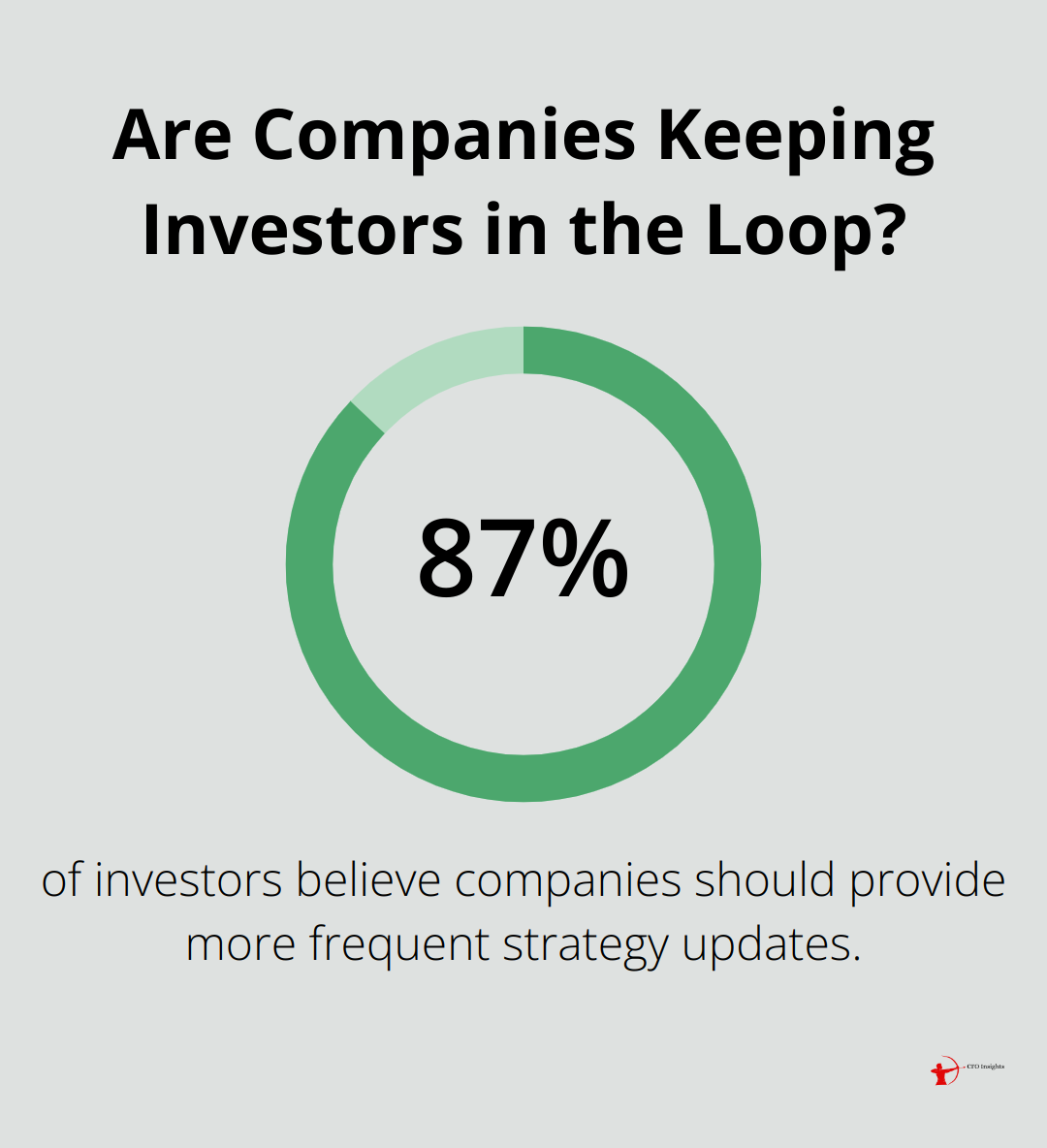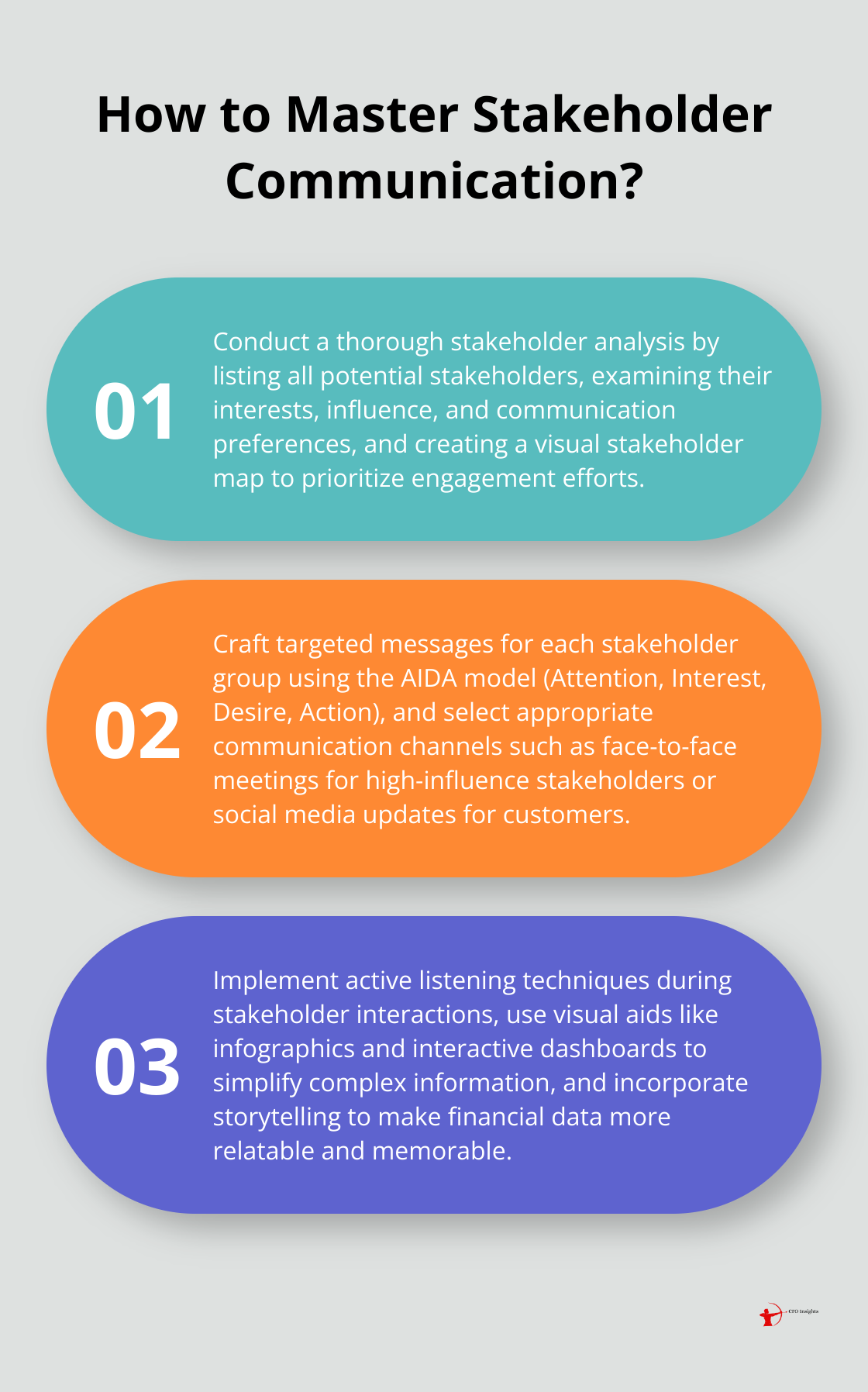Effective stakeholder communication is a cornerstone of successful business operations. At CFO Insights, we’ve seen how strong engagement strategies can drive organizational success and foster positive relationships.
This blog post will explore practical methods on how to ensure stakeholder engagement through targeted communication techniques. We’ll cover everything from identifying key stakeholders to implementing tailored communication plans that resonate with each group.
Who Are Your Key Stakeholders?
Defining Stakeholder Categories
Stakeholders typically fall into four main categories based on their level of interest and influence:
- High Interest, High Influence: These are your key players (often including major investors, board members, and top executives).
- High Interest, Low Influence: This group might include employees or smaller shareholders who are deeply invested but have less decision-making power.
- Low Interest, High Influence: Regulatory bodies or industry leaders often fall here. They can significantly impact your business but may not be actively engaged day-to-day.
- Low Interest, Low Influence: This could include the general public or distant market segments.

Understanding these categories helps prioritize communication efforts and resources.
Conducting Stakeholder Analysis
A thorough stakeholder analysis involves more than just categorization. It requires an in-depth examination of each stakeholder’s motivations, concerns, and communication preferences.
Start by listing all potential stakeholders. Then, for each one, consider:
- What are their primary interests in your organization?
- How much influence do they wield over your operations or decision-making?
- What’s their preferred method of communication?
- How frequently do they expect updates?
This analysis forms the basis of your engagement strategy. For instance, companies can dramatically improve investor relations by simply aligning their reporting frequency with stakeholder expectations.
Creating a Stakeholder Map
A visual representation of your stakeholders can be an invaluable tool. Create a two-axis grid with ‘Interest’ on one axis and ‘Influence’ on the other. Plot each stakeholder group accordingly.
This map serves multiple purposes:
- It provides a quick reference for prioritizing communication efforts.
- It helps identify potential alliances or conflicts between stakeholder groups.
- It can reveal gaps in your current engagement strategy.
Stakeholder positions aren’t static. Regular reviews of your stakeholder map (we recommend quarterly) ensure your strategy remains aligned with shifting dynamics.
Leveraging Technology for Stakeholder Management
Modern stakeholder management goes beyond manual tracking. Stakeholder Relationship Management (SRM) software works with your stakeholder engagement plan, allowing you to work in a more streamlined and organized manner.
These platforms can be particularly useful for organizations dealing with a large number of stakeholders. One energy sector company saw a 40% increase in stakeholder satisfaction scores after implementing a dedicated stakeholder management system.
The Role of CFO Insights in Stakeholder Management
At CFO Insights, we specialize in providing fractional CFO services that can significantly enhance your stakeholder management efforts. Fractional CFOs bring a wealth of expertise, including funding negotiations, optimizing financial operations, and aiding senior management with strategic decisions. This approach can be particularly beneficial when communicating with high-interest, high-influence stakeholders who often require detailed financial information and strategic outlooks.
As we move forward to discuss developing a tailored communication plan, it’s important to note that the groundwork laid in stakeholder identification and mapping will directly inform your communication strategies. The next section will explore how to craft messages that resonate with each stakeholder group, ensuring that your communication efforts are both efficient and effective.
How to Craft a Targeted Communication Plan
Setting Clear Communication Objectives
The first step in creating a targeted communication plan is to establish clear objectives. These objectives should align with your overall business goals and address the specific needs of each stakeholder group. For example, if your goal is to secure additional funding, your communication objective might be to provide detailed financial projections and growth strategies to potential investors.

Research shows that overall success is strongly influenced by ISO/PMBOK project management processes, thus reinforcing the relevance of competent project management in achieving objectives.
Selecting the Right Communication Channels
Choosing the appropriate communication channels for each stakeholder group is essential for effective engagement. Different stakeholders prefer different methods of communication, and it’s important to meet them where they are.
For high-influence stakeholders (like board members or major investors), face-to-face meetings or video conferences might be most appropriate. For employees, a mix of email updates, intranet posts, and team meetings could be more effective. Customers might prefer social media updates or newsletters.
Modern customers have much higher expectations, such as proactive service, personalized interactions, and connected experiences across digital channels.
Crafting Targeted Messages
Once you’ve identified your objectives and channels, it’s time to create targeted messages for each stakeholder group. These messages should address the specific interests and concerns of each group, using language and terminology that resonates with them.
For financial stakeholders, focus on metrics and KPIs that demonstrate the company’s financial health and growth potential. For employees, emphasize how company initiatives align with their career development and job security. For customers, highlight how your products or services solve their problems or improve their lives.
A Gallup study on the effect of communication in organizations found that employees who work in an environment with effective communication show improved performance.
When you craft your messages, consider using the AIDA model: Attention, Interest, Desire, and Action. This framework helps ensure your communication is engaging and prompts the desired response from your stakeholders.
Maintaining Consistency Across Communications
While the specific content may vary for different stakeholder groups, the overall brand message and company values should remain constant. This consistency helps build trust and reinforces your organization’s identity across all stakeholder interactions.
Soliciting Feedback and Refining Your Approach
A targeted communication plan requires ongoing effort and refinement. Regularly ask for feedback from your stakeholders and be prepared to adjust your approach based on their responses. This iterative process ensures that your communication strategy remains effective and relevant over time.
As we move forward to discuss implementing effective communication techniques, it’s important to note that the foundation laid in your targeted communication plan will directly inform your day-to-day interactions with stakeholders. The next section will explore practical methods to bring your communication strategy to life, ensuring that your engagement efforts are both impactful and sustainable.
How to Maximize Stakeholder Communication Impact
The Power of Active Listening
Active listening forms the foundation of effective communication. It requires full concentration, understanding, and response to stakeholder input. This technique improves stakeholder satisfaction and decision-making quality.

A Harvard Business Review study revealed that leaders who practice active listening are perceived as 40% more effective than those who don’t. This directly impacts stakeholder relationships. Stakeholders who feel heard engage more positively with organizations.
To practice active listening:
- Provide full attention during stakeholder interactions
- Paraphrase and summarize to confirm understanding
- Ask open-ended questions to encourage deeper discussion
- Acknowledge emotions and concerns
Leveraging Visual Communication
In our data-driven world, visual aids and data visualization prove invaluable for stakeholder communication. These tools simplify complex information, highlight key trends, and make messages more memorable.
Managing stakeholders’ expectations and interests is key to a project’s success. Identifying stakeholders at the beginning of the project is crucial for effective communication.
Effective visual communication strategies include:
- Infographics for summarizing key data points
- Interactive dashboards for real-time financial reporting
- Video presentations for complex project updates
The Art of Business Storytelling
Storytelling engages stakeholders emotionally and intellectually. It makes financial data more relatable and helps stakeholders understand the ‘why’ behind strategies and decisions.
Stories are 22 times more effectively recalled by the brain than simple facts, according to a Stanford University study. When crafting stakeholder communications, consider:
- Using real-world examples or case studies
- Highlighting the human impact of financial decisions
- Structuring your message with a clear beginning, middle, and end
Implementing Feedback Loops
Regular updates and feedback loops maintain strong stakeholder relationships. They demonstrate transparency, show that you value stakeholder input, and allow for continuous improvement of communication strategies.
A PwC survey found that 87% of investors believe companies should provide more frequent strategy updates. To implement effective feedback loops:
- Schedule regular check-ins with key stakeholders
- Use surveys or polls to gather feedback on communication efforts
- Act on the feedback received and communicate the changes made
Effective stakeholder communication requires ongoing effort. These techniques help build stronger, more productive relationships with all stakeholders. Organizations that prioritize these strategies (including those working with CFO Insights) often see significant improvements in stakeholder engagement and overall business performance.
Final Thoughts
Effective stakeholder engagement forms the bedrock of successful business operations. We explored strategies to ensure stakeholder engagement, from identification and mapping to tailored communication plans and impactful techniques. Understanding the unique needs of each stakeholder group allows organizations to craft targeted messages that drive meaningful engagement.

Ongoing communication builds a culture of transparency and trust. Visual aids, data visualization, and storytelling enhance understanding of complex information, making messages more memorable and impactful. At CFO Insights, we support organizations in developing robust stakeholder communication strategies through our fractional CFO services.
The stakeholder engagement landscape constantly evolves. Organizations must stay adaptable, seek regular feedback, and adjust their approach based on stakeholder responses. Prioritizing effective communication and improving stakeholder relationships builds a strong foundation for long-term success and growth.
One thought on “Effective Stakeholder Engagement Communication Strategies”
Leave a Reply
You must be logged in to post a comment.





[…] the concept of owning the right part of the right property, you may also find the article on effective stakeholder engagement communication strategies to be insightful. This article delves into the importance of engaging with stakeholders in a […]